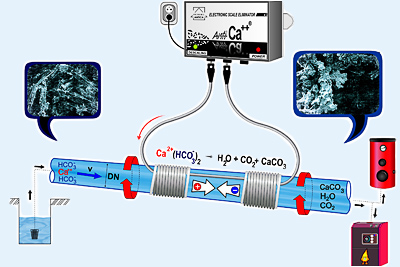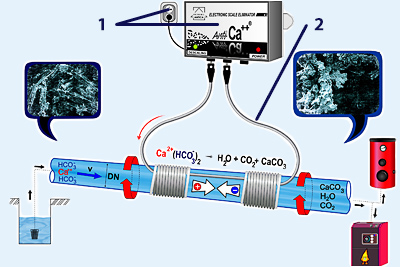Fundamentals
The lime scale problem in liquid arises with increased temperature and pressure where the solubility of CaCO3 (carbon calcite) in new liquid physical state decreases. In nature two common liquid soluble forms of carbon calcite co-exist. Carbon calcite that forms hard scale and aragonite carbon calcite that does not form hard scale. When hard water has flown through AntiCa++ device, the magnetic or electromagnetic field applied to the flowing water changes the liquid (architecture) structure promoting change from scale forming carbon calcite to aragonite carbon calcite. In carbon steel piping systems it promotes formation of Fe3 O4 protective film, thus inhibits steel pipe and components internal corrosion. (2)
Illustration of typical installation of an AntiCa++ device and benefits are shown below.


| (2)Crystals forms of CaCO3 | Calcite % | Aragonite % |
|---|---|---|
| Tap Water | 65 | 35 |
| Magnetic water treatment | 27 | 73 |
(2) Source : International Journal of Applied Chemistry ISSN 0973-1792 Vol.1 No.1(2005), pp. 84-89
© Research India Publication http://www.ripublication.com/ijak/htm
The Effect of Magnetic Field on Scale Prevention
in the Industrial Boilers by M. Gholizadeh, H. Arabshahi and M.R. Benam.
“Abstract (2)
We have investigated the effect of magnetic field on the scale formation in the industrial boilers. It was found that passing water through a static magnetic field about 6000 G reduces the scale formation and protects the boiler from internal corrosion. It seems that the presence of the magnetic field modifies the local ionic concentrations via Lorentz Force and therefore changes the morphology of the mineral crystals. This effect causes the shape of the crystals change from a dendristic form to a disk-shape form that is less likely to form a scale.
Today, advances in magnetic and electrostatic scale control technologies have led to their becoming reliable energy savers in certain applications [1-4]. For example, magnetic or electrostatic scale control technologies can be used as a replacement for most water-softening equipment. Specifically, chemical softening (lime or lime-soda softening), ion exchange, and reverse osmosis, when used for the control of hardness, could potentially be replaced by non-chemical water conditioning technology. This would include applications both to cooling water treatment and boiler water treatment in once-through and recirculating systems [5-6].”
BENEFITS of AntiCa++ device
NEW HOT WATER SYSTEM
When a maintenance free AntiCa++ device is installed on a new hot water system supplied with hard water, the system remains scale and corrosion free (2) keeping the system thermal and mechanical efficiency close to the initial rated efficiency. It reduces or eliminates the possibility of hot water heater tank failure from overpressure due to scale formation on fittings located inside of the glass tank after the sacrificial anode installed by the hot water heater manufacturer is exhausted (about 5 to 6 years after new boiler instillation). The frequency of hot water heater – boiler – replacement with its associated cost is reduced with reduced thermal stress in domestic, commercial and industrial installations.
Maintenance free AntiCa++ device that is installed on a hot water system the system retains system’s high thermal efficiency, a constant life cycle carbon emission and associated carbon tax.
In an open ended hot water systems the formed aragonite carbon calcite is flushed with water use.
In recirculating closed hot water systems inline filters and mud separators must be installed to remove the cumulating “mud” from the system.
EXISTING HOT WATER SYSTEM
When an AntiCa++ device is installed on an existing scaled hot water system, in time the cumulated scale “softens” and is removed with the flowing liquid in form of flakes (2). In an open system the removed old scale and aragonite mud are removed from the system by water use. In closed hot water systems the removed scale and formed aragonite mud must be removed by mud traps or filters.
In time the gained system efficiency reduces pumping power and system heating energy consumption. The increased system efficiency reduces the total life carbon emission of the system and the associated carbon tax. The installed carbon steel piping system is protected against internal corrosion.
AntiCa++ electronic device components

An AntiCa++ electronic device consists of:
- Separate surface mounted sealed electronic unit with power cable.
- Loose supplied silicone insulated cable.The sealed electronic unit protects the electronic parts against moisture and chemicals thus render the product high reliability and long service life. The electronic units are suitable for indoor or outdoor installation to low ambient temperature of – 50°C.The silicone insulated cable is resistant to most chemicals and is temperature rated to +170°C. It is suitable for installation on metallic or plastic pipe up to and including 1000 mm (40”) pipe diameter. The cable is manually affixed and coiled with the required distance to the second coil that is wounded in the same direction see diagram above. The number of coils is in accordance with the treated liquid hardiness, the pipe diameter and the liquid pipe velocity. The powered electronic unit generates the required magnetic field transferred through the coils into the flowing treated liquid.

